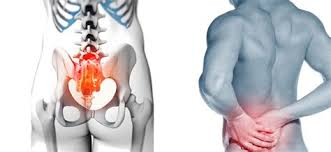
The sacroiliac joint (SIJ) is a very common source of low back pain, and many times is misdiagnosed as a problem with the discs or the spine. The first key to understanding SIJ pain is understanding the anatomy. There are two SIJ’s in your body, located on either side of the triangle-shaped bone at the bottom of your spine where it connects to your pelvis. The SIJ’s are a shock absorber for your spine and provide stability for your body as you run, walk, or jump. The most the joint moves in sliding is probably only 2-4 millimeters, and may tilt and rotate two or three degrees.
The SI joint is held together by several large, very strong ligaments. The strongest ligaments are in the back of the joint outside of the pelvis. Because the pelvis is a ring, these ligaments work somewhat like the hoops that hold a barrel together. If these ligaments are torn or become lax, the pelvis can become unstable. Muscles of the back and pelvis are functionally connected to the SIJ ligaments therefore their actions can affect joint mobility.
HOW DO YOU KNOW IF THE PAIN YOU’RE FEELING IS BEING CAUSED BY A SIJ PROBLEM?
There are some common symptoms:
- Low back pain: usually a dull ache on one side of your lower back that may extend into the thigh or groin. It is usually below the L5, or lowest lumbar vertebrae.
- Buttock pain: pain can range from an ache to a sharp stabbing pain that extends down one or both legs
- Low back pain while climbing stairs: activities that require weight transfer to one leg at a time, which require the pelvis to twist may produce SIJ pain. Possibly even feeling that your leg may buckle or give way.
- Difficulty sitting or lying on one side: often experienced as an ache on one side that causes you to shift weight to one side to relieve the pain in the other.
WHAT TREATMENTS ARE AVAILABLE FOR SIJ PAIN?
Physiotherapy treatment for patients with this condition is vital to hasten the healing process, ensure the best outcome and decrease the likelihood of injury recurrence. Treatment may include:
- Joint mobilisation and/or manipulation
- Spinal and pelvic realignment
- Dry needling / acupuncture
- Deep tissue massage / mysofascial release
- Ultrasound / electrotherapy
- Neural mobilization
- Ice or heat treatment
- Taping
Treatment will also look at addressing any underlying muscle imbalances and postural alignment issues that would affect the SIJ. This may include stretching exercises for shortened tight muscles, as well as strengthening exercises for weak muscles commonly those around the buttocks and abdomen. Your therapist will assess your daily activities and correct any ergonomic problems that could be contributing to your pain, which may also require referral to an occupational therapist. Should you have a leg length discrepancy the therapist will advise on orthotics or inner soles and this too may require a referral.











